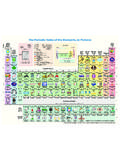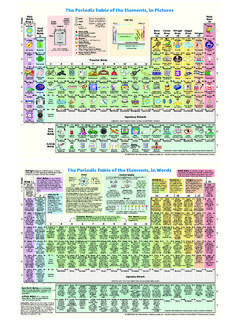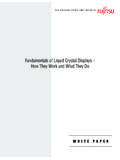Transcription of The Periodic Table of the Elements, in Words
1 The Periodic Table of the Elements, in Pictures Alkali Noble Solid The color of the symbol is Metals Atomic Gases Periods Number the color of the element in Color Key Group 1 Atomic number of Liquid its most common pure form. 18. Symbol protons Examples metallic solid Metals Nonmetals H 1 Gas red liquid He 2. Hydrogen Symbols at room colorless gas Helium Alkali temperature H. 1 Earth A Z Human Body Boron Carbon Nitrogen Oxygen 1. Noble Gases No Alkali Earth Metals Metals _____ium Group Group Group Group Halogens nm tallo or top ten elements by weight Alkali Metals Halogens et Me Sun and Earth's Crust 2 13 14 15 16 17. als ids Stars Name top eight elements by weight Transition Metals Balloons Po als Me Li 3 Be 4 Magnetic B 5C 6N 7O 8F 9 Ne 10. t Lithium Beryllium ferromagnetic at room temperature Boron Carbon Nitrogen Oxygen Fluorine Neon Widgets Noble Metals Superheavy Elements corrosion-resistant 2 Radioactive 2.
2 Rare Earth Metals all isotopes are radioactive How it is (or was) used Actinide Metals Only Traces Found in Nature Sports Basis of Life's Advertising Batteries Emeralds or where it occurs in nature less than a millionth percent of earth's crust Equipment Molecules Protein Air Toothpaste Signs Na 11 Mg 12 Never Found in Nature Al 13 Si 14 P 15 S 16 Cl 17 Ar 18. Sodium Magnesium only made by people Aluminum Silicon Phosphorus Sulfur Chlorine Argon 3 3. Transition Metals Stone, Sand, Swimming Salt Chlorophyll 3 4 5 6 7 8 9 10 11 12 Airplanes and Soil Bones Eggs Pools light Bulbs K 19 Ca 20 Sc 21 Ti 22 V 23 Cr 24 Mn 25 Fe 26 Co 27 Ni 28 Cu 29 Zn 30 Ga 31 Ge 32 As 33 Se 34 Br 35 Kr 36. Potassium Calcium Scandium Titanium Vanadium Chromium Manganese Iron Cobalt Nickel Copper Zinc Gallium Germanium Arsenic Selenium Bromine Krypton 4 4. Fruits and Shells and Stainless Steel Electric Brass light - emitting Semiconductor Photography Vegetables Bones Bicycles Aerospace Springs Steel Earthmovers Structures Magnets Coins Wires Instruments Diodes (LEDs) Electronics Poison Copiers Film Flashlights Rb 37 Sr 38 Y 39 Zr 40 Nb 41 Mo 42 Tc 43 Ru 44 Rh 45 Pd 46 Ag 47 Cd 48 In 49 Sn 50 Sb 51 Te 52 I 53 Xe 54.
3 Rubidium Strontium Yttrium Zirconium Niobium Molybdenum Technetium Ruthenium Rhodium Palladium Silver Cadmium Indium Tin Antimony Tellurium Iodine Xenon 5 5. Global Chemical Mag Lev Cutting Radioactive Electric Searchlight Pollution Liquid Crystal Plated Car Thermoelectric High-Intensity Navigation Fireworks Lasers Pipelines Trains Tools Diagnosis Switches Reflectors Control Jewelry Paint Displays (LCDs) Food Cans Batteries Coolers Disinfectant Lamps Cs 55 Ba 56 57 - 71 Hf 72 Ta 73 W 74 Re 75 Os 76 Ir 77 Pt 78 Au 79 Hg 80 Tl 81 Pb 82 Bi 83 Po 84 At 85 Rn 86. Cesium Barium Hafnium Tantalum Tungsten Rhenium Osmium Iridium Platinum Gold Mercury Thallium Lead Bismuth Polonium Astatine Radon Rare 6 Earth 6. Metals Atomic X-Ray Nuclear Mobile Lamp Rocket Low-Temperature Fire Anti-Static Radioactive Surgical Clocks Diagnosis Submarines Phones Filaments Engines Pen Points Spark Plugs Labware Jewelry Thermometers Thermometers Weights Sprinklers Brushes Medicine Implants Fr 87 Ra 88 89 - 103 Rf 104 Db 105 Sg 106 Bh 107 Hs 108 Mt 109 Ds 110 Rg 111 Cn 112 Nh 113 Fl 114 Mc 115 Lv 116 Ts 117 Og 118.
4 Francium Radium Rutherfordium Dubnium Seaborgium Bohrium Hassium Meitnerium Darmstadtium Roentgenium Copernicium Nihonium Flerovium Moscovium Livermorium Tennessine Oganesson Actinide 7 Metals 7. Superheavy Elements Laser Luminous Atom Traps Watches radioactive, never found in nature, no uses except atomic research 119 120 8 La 57 Ce 58 Pr 59 Nd 60 Pm 61 Sm 62 Eu 63 Gd 64 Tb 65 Dy 66 Ho 67 Er 68 Tm 69 Yb 70 Lu 71. Lanthanum Cerium Praseodymium Neodymium Promethium Samarium Europium Gadolinium Terbium Dysprosium Holmium Erbium Thulium Ytterbium Lutetium Rare Earth 6. Metals Telescope Lighter Torchworkers' Electric Motor Luminous Electric Motor Color MRI Fluorescent Smart Material Laser Optical Fiber Laser Scientific Photodynamic Lenses Flints Eyeglasses Magnets Dials Magnets Televisions Diagnosis Lamps Actuators Surgery Communications Surgery Fiber Lasers Medicine Ac 89 Th 90 Pa 91 U 92 Np 93 Pu 94 Am 95 Cm 96 Bk 97 Cf 98 Es 99 Fm 100 Md 101 No 102 Lr 103.
5 Actinium Thorium Protactinium Uranium Neptunium Plutonium Americium Curium Berkelium Californium Einsteinium Fermium Mendelevium Nobelium Lawrencium Actinide Metals 7. Radioactive Gas Lamp Radioactive Nuclear Radioactive Nuclear Smoke Mineral Radioactive Mineral Medicine Mantles Waste Power Waste Weapons Detectors Analyzers Waste Analyzers radioactive, never found in nature, no uses except atomic research 2005 2016 Keith Enevoldsen Creative Commons Attribution-ShareAlike International License Hydrogen belongs to no definite group. It forms compounds by either donating an electron like an alkali The Periodic Table of the Elements, in Words Noble Gases are inactive, or inert. Each atom has exactly the number of electrons it needs to have metal or accepting an electron like a halogen. Atoms Chemical Bonding a full outer shell, so these atoms almost never bond with other atoms.
6 That is why these are all gases. Nucleus of Atoms form molecules by bonding together. Atoms give, take, or Alkali Metals are very reactive Particles share electrons to achieve full outer electron shells. Periods protons and and readily form compounds but are neutrons +1 Proton Metalloids are Nonmetals, in Halogens are reactive Group 1 not found free in nature. They form 0 Neutron Na Cl H O H Ag Ag partly like metals and their solid state, nonmetals and readily 18. salts and alkali (acid-neutralizing) -1 Electron partly like nonmetals. are usually brittle form compounds but are Electron Ag Ag Ag H Hydrogen 1 compounds such as baking soda. In H H For example, they are (they break rather not found free in nature. He Helium 2. explosive gas, shells Na +. Cl - O inert gas, second Ag Ag semiconductors, which than bend) and They combine with alkali lightest element; pure form, they are very soft metals Salt Water Silver lightest element.
7 An atom has a nucleus, made of protons and neutrons, 90% of atoms in which catch fire on contact with means they conduct they are insulators metals to form salts nuclear fusion surrounded by electrons orbiting in cloud-like shells. 1 the universe, sun and stars, water. Smaller shells are surrounded by larger shells. Ionic bond Covalent bond Metallic bond electricity in some of both heat and (halogen means in sun and stars, 1. One atom takes an Atoms share their Shared outer conditions. electricity. salt-former). balloons, water (H20), The atomic number is the number of protons in an atom. electron from another outer electrons. electrons flow, lasers, life's organic Alkali Earth This determines the chemical properties of the atom. atom and the oppositely conducting heat supercold molecules 2 Metals are reactive Protons have positive electric charge, neutrons are neutral, charged ions attract.
8 And electricity. 13 14 15 16 17 refrigerant Li Lithium 3 Be Beryllium 4 and readily form and electrons are negative. Normally, an atom has equal Groups B Boron 5 C Carbon 6 N Nitrogen 7 O Oxygen 8 F Fluorine 9 Ne Neon 10. lightest metal, lightweight metal; compounds but are numbers of protons and electrons. An ion is a charged atom Elements in the same group, or column, are similar because they hard black solid; hard diamond, colorless gas; colorless gas; yellowish inert gas;. soft, reactive; non-sparking not found free in with more or fewer electrons than protons. typically have the same number of outer electrons. This Table borax soap, soft graphite; 78% of air, 21% of air, H2O, poison gas, orange-red lightweight copper alloy tools, nature. Their oxides The atomic weight of an element is the average number of shows some easy-to-remember common numbers for each group.
9 Fertilizer, basis of life's organic molecules, 65% of the body, most reactive neon tubes for 2 aluminum alloys, aerospace, are called alkali protons plus neutrons. You can easily estimate the atomic stiff fibers, organic molecules, protein, muscles, organic molecules, element; advertising signs, 2. batteries, X-ray windows, weight: it is usually 2 to times the atomic number. Group number 1 2 3-12 13 14 15 16 17 18 sports equipment, animals, plants, DNA, ammonia, blood, breathing, glowing fluorite, lasers, impact-resistant beryl gems: earths. In pure Outer electrons* 1 2 2 3 4 5 6 7 8 heat-resistant CO2, wood, paper, fertilizer, fire, half of toothpaste, supercold ceramic cookware, emeralds and form, they are soft An element is a substance made from one or more atoms of Valence number* +1 +2 +2 +3 +4,-4 -3 -2 -1 0 borosilicate glass, cloth, plastic, explosives (TNT), Earth's crust, nonstick cookware, refrigerant mood stabilizer aquamarines and somewhat brittle the same atomic number.
10 A compound is a substance made semiconductors coal, oil, gasoline refrigerants minerals, oxides CFC refrigerants from two or more elements chemically bonded. * typical The valence number is the number of electrons Na Sodium 11 Mg Magnesium 12 metals. given (+) or taken (-) when bonding. Al Aluminum 13 Si Silicon 14 P Phosphorus 15 S Sulfur 16 Cl Chlorine 17 Ar Argon 18. soft metal, lightweight metal; lightweight non- hard metalloid; glowing white waxy brittle yellow solid; greenish poison gas; inert gas;. reactive; chlorophyll in corroding metal; quartz, granite, solid (also red skin, hair, salt (NaCl), bleach, 1% of air, salt (NaCl), nerves, green plants, Transition Metals are typical metals: they are strong, shiny, Poor Metals are usually kitchenware, cans, sand, soil, clay, and black forms); eggs, onions, stomach acid, most abundant 3 baking soda, antacids, lye, soap, talc, basalt, aluminum alloys, malleable (they can be hammered into shape), flexible (in thin soft and have low melting foil, machinery, ceramics, glass, bones, DNA, garlic, skunks, disinfectant, inert gas, 3.)






